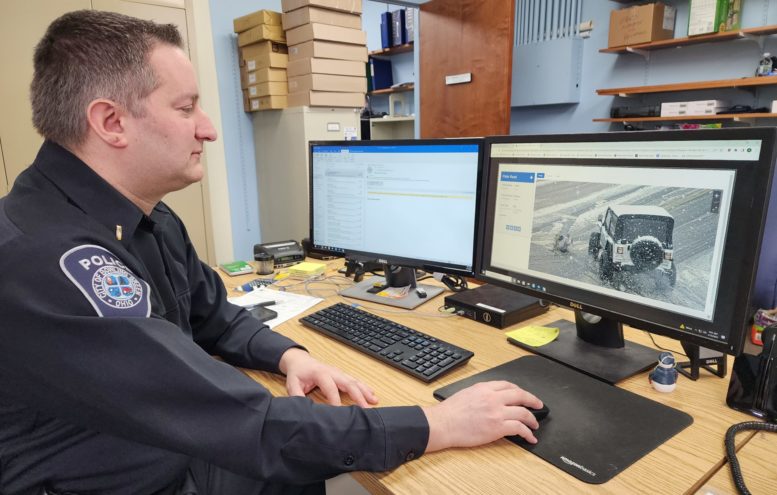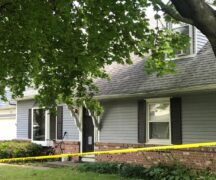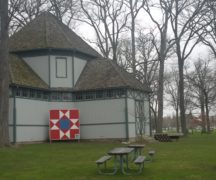By JAN LARSON McLAUGHIN
BG Independent News
The video footage shows a Jeep rounding the corner, plowing into a pedestrian crossing at East Wooster Street and South College Avenue. The street is slick with snow and somehow the Jeep pushes the woman’s body out of its path rather than rolling over her.
The driver reportedly denied knowing that he hit the pedestrian, but the city’s new license plate cameras caught a crystal clear image of the Jeep’s plate.
“That worked out great,” Bowling Green Police Division Lt. Adam Skaff said of the hit and run case.
Since July of 2022, BGPD has had the help of 20 Rekor license plate cameras posted throughout the city.
Last week alone, 824,694 vehicle images were recorded in Bowling Green.
As extra sets of eyes – with keen vision – the cameras have resulted in the seizing of stolen vehicles and capture of suspects with arrest warrants. They have identified vehicles used in child abductions, assaults, shoplifting cases and catalytic converter thefts.
“The amount of stuff we’ve solved in the first first months is crazy,” Skaff said. “We’ve had more stolen cars recovered since the last four or five years.”
The 20 cameras are posted at the more traveled entry points to Bowling Green, and along the main thoroughfares in the city. The cost was approximately $24,000 for the system, Skaff said.
These cameras supplement the existing downtown cameras, which have been vital to the Police Division being able to gather evidence in a large number of incidents including assaults, shootings and car accidents.
However, in many cases the downtown cameras are unable to capture the license plates of involved vehicles, especially at night – in contrast to the Rekor license plate cameras which are highly effective at night, Skaff said. Without a license plate, investigations are more difficult and time consuming.
“This adds one more layer,” he said of the license plate cameras.
Skaff listed examples of limitations with the existing cameras:
- During a shooting outside a downtown bar, the suspect vehicle was on numerous cameras, but its license plate was unreadable.
- The cameras caught several images of a hit-skip crash in the downtown area, but no clear image of the license plate.
- Cameras at Bowling Green State University captured several images of a vehicle suspected in the break-ins of vehicles on campus, but the license plate was unreadable.
- After a robbery at a local hotel, police got a vehicle description and camera footage, but no license plate.
“The robbery at the hotel would have been solved in 30 seconds,” Skaff said.
The investigation of the shooting downtown took a great deal of time because witnesses and data from other downtown cameras could only give a partial plate. It then took hours for an officer to narrow down the exact plate through the process of elimination.
“Without that data, it’s extremely difficult,” Skaff said.
Since in place, the license plate cameras have alerted BGPD and helped with several cases, such as a felony warrant arrest, recovery of stolen vehicles, drug investigations and the search for a missing juvenile. The cameras have been used to identify vehicles involved in thefts and hit-skip crashes, and helped catch suspects involved in thefts in other communities when they arrive in Bowling Green.
“A lot of our crime comes from elsewhere. The vehicle is the best way to identify that person,” Skaff said.
When a camera spots a plate of a stolen vehicle, within 10 seconds it sends an alert to BGPD. Before a message is sent out to patrolling officers, dispatchers must verify that the vehicle is still stolen before officers are told to pursue.
The license plate cameras not only identify the plates, but also the make, model and color of the vehicles. So BGPD can ask the system to bring up every blue Ford Taurus during a certain time period, and all such cars will pop up on the computer screen.
The cameras can be programmed to look for specific license plates, such as:
- In the case of a local manufacturer where a former employee returned and threatened people at the plant, one camera near the business can be programmed to alert if the license plate of the ex-worker comes into view.
- In cases where a protection order is violated, the cameras can show proof that the vehicle was or was not in the area.
- The cameras can not only show where a vehicle was, but also where it wasn’t. The series of cameras along East Wooster Street may alert when a stolen vehicle gets off Interstate 75 and heads into the city. When the vehicle isn’t picked up by the next camera, police can presume the vehicle turned off Wooster between the consecutive cameras.
Skaff has heard the concerns about the cameras infringing on privacy.
“A lot of people worry about Big Brother,” he said. But the cameras don’t show the inside of vehicles, are limited to main streets – not neighborhoods, and officers must write down a justifiable reason for searching for a particular plate or model prior to doing so.
The camera images are stored for 90 days at the BGPD, then are stored on the Cloud.
The license plate cameras can also provide data for non law enforcement purposes. The system provides traffic count analytics on which roads and which times are busiest for traffic. That information can help with the securing of grant funding or the scheduling of construction projects, Skaff said.





